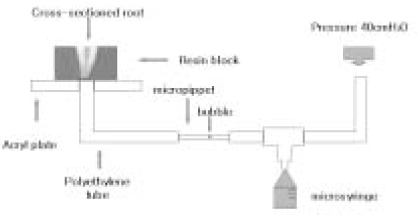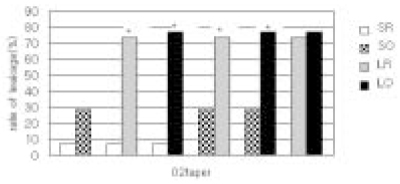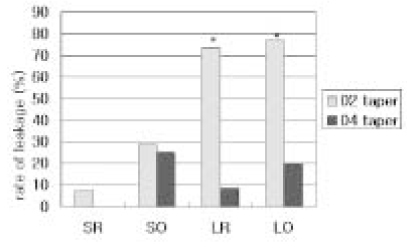J Korean Acad Conserv Dent.
2005 Mar;30(2):95-101. 10.5395/JKACD.2005.30.2.095.
Effect of canal tapering in teeth of various apical size & cross-sectional configuration on microleakage
- Affiliations
-
- 1Department of Conservative Dentistry, School of Dentistry, Chonbuk National University, Korea. endo@chonbuk.ac.kr
- KMID: 1987001
- DOI: http://doi.org/10.5395/JKACD.2005.30.2.095
Abstract
- The aim of this study was to evaluate the microleakage of teeth according to root canal preparation with & without apical enlargement in various size of apical foramen. 60 extracted one canal roots were cross-cutted at 5 mm from root apex and divided into two groups according to their apical foramen size of large (L) and small (S). Each group was subdivided into two groups accordance with their cross-sectional configuration at 5 mm from apex, round (R) and ovoid (O); SR Group, SO Group, LR Group, LO Group. Each group was shaped in .02 taper by Quantec series Nickel-Titanium (NiTi) rotary file, obturated by lateral condensation method. Leakage was measured using a fluid transport model under 40 cmH2O pressure. After the leakage test, blocks which had showed the leakage retreated with .04 taper and .06 taper and evaluated the degree of fluid filtration in each group. The data was analysed statistically using chi-square test and fisher's exact test. The results obtained were as follows: 1. Significant difference in leakage was found in groups which had different apical foramen size in .02 taper instrumentation (p < 0.05), but not in .04 taper instrumentation (p > 0.05). 2. The difference in microleakage according to the shape of canal was not evident at 5 mm from apex (p > 0.05). 3. There was correlation between .02 taper instrumentation and .04 taper instrumentation in LR group , LO group (p < 0.05).
Figure
Reference
-
1. Walton R, Torabinejad M. Principles and practice of endodontics. 1996. 2nd ed. philadelphia: WB Saunder;201–233.2. Grossman L. Endodontic practice. 1985. 10th ed. philadelphia: Lea & Febiger;207.3. Guldener P, Langeland K. Endodoncia. Diagnosticoy tratamiento. 1995. 1a ed. Mexico: Editorial Cuellar;177.4. Cohen S, Burns R. Passway of the pulp. 1994. 6th ed. St. Louis: CV Mosby;179–218.5. Ingle J, Bakland L. Endodontics. 1994. 4th ed. Philadelphia: Lea & Febiger;92–227.6. Mauger MJ, Schindler WG, Walker WA. An evaluation of canal morphology at different levels of root resection in mandibular incisors. J Endod. 1998. 24:607–609.
Article7. Weine FS. Endodontic Therapy. 1996. 5th ed. Mosby;435–436.8. Lim SS. Clinical Endodontics. 1999. 2nd ed. School of Dentistry, Seoul National University: Uichihaksa;131.9. Schilder H. Cleaning & shaping the root canal. Dent Clin North Am. 1974. 18:269.10. Lussi A, Messerli L, Hotz P, Grosrey J. A new non-instrumental technique for cleaning and filling root canal. Int Endod J. 1995. 28:1–6.
Article11. Lussi A, Imwinkelried S, Hotz P, Grosrey J. Long-term obturation quality using noninstrumentation thechnology. J Endod. 2000. 26:491–493.12. Buchanan LS. The standardized-taper root canal preparation-part 2. Int Endod J. 2001. 34:63–71.13. De Moor R, Hommez G. The importance of apical and coronal leakage in the success or failure of endodontic treatment. Rev Belge Med Dent (1984). 2000. 55:334–344.14. Saunders WP, Saunders EM. Coronal leakage as a cause of failure in root canal therapy: a review. Endod Dent Traumatol. 1994. 10:105–108.15. Wu MK, Wesselink PR. Endodontic leakage studies reconsidered. part 1. Methodology, application and relevance. Int Endod J. 1993. 26:37–43.
Article16. Torabinejad M, Ung B, Kettering JD. In vitrobacterial penetration of coronally unsealed endodontically treated teeth. J Endod. 1990. 16:566–569.
Article17. Ingle JI, Beveridge EE, Glick DH, Weighman JA, Abourass M. Mordern endodontic therapy. The Washington study. Int Endod Philadelphia. 1985. 27–49.18. Mccomb D, Smith DC. A preliminary scanning electron microscopic study of root canal after endodontic procedures. J Endod. 1975. 1:238–242.
Article19. Safavi KE, Nichols FG. Effect of calcium hydroxide on bacterial lipopolysacchalide. J Endod. 1993. 19:76–78.20. Love RM. Enterococcus faecalis-a mechanism for its role in endodontic faliure. Int Endod J. 2001. 34:339–405.21. Love RM. The effect of tissue molecules on bacterial invasion of dentine. Oral Microbiol Immunol. 2002. 17:32–37.
Article22. Wu MK, Wesselink PR. A primary observation on the preparation and obturation in oval canals. Int Endod J. 2001. 34:137–141.23. Nagy CD. The effect of root canal morphology on canal shape following instrumentation using dfferent techniques. Int Endod J. 1997. 30:133–140.
Article24. Kerekes K, Tronstad L. Morphomeric observation on root canals of human anterior teeth. J Endod. 1977. 3:24–29.25. Kerekes K, Tronstad L. Morphomeric observation on root canals of human anterior teeth. J Endod. 1977. 3:24–29.26. Kerekes K, Tronstad L. Morphomeric observation on root canals of human molar. J Endod. 1977. 3:114–118.27. Pashley DH, Andringa HJ, Derkson GD, Derkson ME, aKalathoor SR. Resional variability in the permeability of human dentine. Arch Oral Biol. 1987. 32:519–523.28. Outhwaite WC, Livingston MJ, Pashley DH. Effects of changes in surface area, thickness, temperature and post-extration time on human dentine permeability. Arch Oral Biol. 1976. 21:599–603.
Article29. Derkson GD, Pashley DH, Derkson ME. A new in vitro method. J Prosthet Dent. 1986. 56:435–440.30. Wu MK, Wesselink PR. Fluid transport and dye penetration along root canal fillings. Int Endod J. 1994. 27:233–238.
Article31. Wu MK, Wesselink PR, Moorer WR. Fluid transport and bacterial penetration along root canal fillings. Int Endod J. 1993. 26:203–208.
Article32. Pommel L, Camps J. Effect of Pressure and Mesurement time on the fluid filtratiom method in endodontics. J Endod. 2001. 27:256–258.
Article33. Sabala CL, Biggs JT. A standard predetermined endodontic preparation concept. Compendium. 1991. 12:656–660.34. Allison CA, Weber CR, Walton RE. The influence of the method of canal preparation on the quality of the apical and coronal obturation. J Endod. 1979. 5:298.
Article35. Wu MK, Barkis D, Roris A, Wesselink PR. Does the first file to bind correspond to the diameter of the apical region? Int Endod J. 2002. 35:264–267.
Article36. Coldero LG, Mchugh S, Saunders WP. Reduction in intracanal bacteria during root canal preparation with and without apical enlarement. Int Endod J. 2002. 35:437–446.
Article
- Full Text Links
- Actions
-
Cited
- CITED
-
- Close
- Share
- Similar articles
-
- Evaluation of the influence of apical sizes on the apical sealing ability of the modified continuous wave technique
- Cross-sectional morphology and minimum canal wall widths in C-shaped root of mandibular molars
- The effects of EDTA and pulsed Nd:YAG laser on apical leakage of canal obturation
- Microleakage of resilon: Effects of several self-etching primer
- The effect of C-factor and volume on microleakage of composite resin restorations with enamel margins





